|
|

|
|
Author
|
Topic: Ares I recovery parachute tests
|
Robert Pearlman
Editor Posts: 50516
From: Houston, TX
Registered: Nov 1999
|
 posted 09-01-2006 05:00 PM
posted 09-01-2006 05:00 PM
   
NASA release NASA recently completed a series of tests that will aid in the design and development of a parachute recovery system for the rocket and capsule that will return astronauts to the moon and later support missions to Mars. The system will be used for the first stage booster of the Ares I crew launch vehicle and for Orion, the new crew exploration vehicle. NASA and industry engineers traveled to the U.S. Army's Yuma Proving Ground, Ariz. to conduct drop tests of the two parachute systems during the week of Aug. 14. The Ares I tests collected performance data on a pilot parachute, the first to be unfurled in a three-stage recovery system NASA is developing for the rocket's first stage. The system includes a pilot, drogue and three main parachutes. The system is derived from the space shuttle's solid rocket booster recovery system. The pilot chute, 11.5 feet in diameter, was packed and mounted inside a 1,500-pound drop test vehicle. Instruments and a recorder were mounted inside the test vehicle to capture data on the speed, weight on the parachute lines and pressure during descent from an altitude of 10,000 feet. The Ares I first stage booster Recovery System Development Test Program is a two-year effort. Six additional pilot parachute tests will be conducted through 2008. Tests are also planned for the drogue and main parachutes. NASA's Marshall Space Flight Center, Huntsville, Ala., is responsible for project management of the Ares I first stage and leads the design and development of the solid rocket booster recovery system. ATK Launch Systems, Brigham City, Utah, is the prime contractor for the first stage booster. ATK's subcontractor, United Space Alliance, Houston, is responsible for the design, development and test of the parachutes at their facilities at the Kennedy Space Center, Fla. The Johnson Space Center, Houston, hosts the Constellation Program and Orion Project Office and provides test instrumentation and support personnel. Yuma Proving Ground is providing the test range; support facilities and equipment.
|
Robert Pearlman
Editor Posts: 50516
From: Houston, TX
Registered: Nov 1999
|
 posted 10-02-2007 01:47 PM
posted 10-02-2007 01:47 PM
   
NASA release First Test: Main Parachute for Ares I Rocket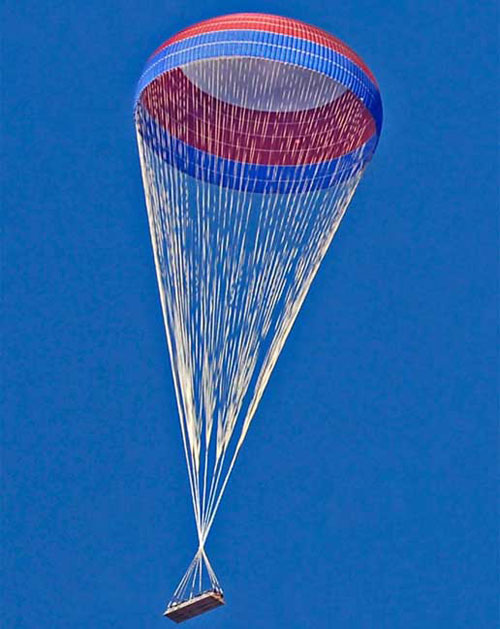
NASA and industry engineers successfully completed the first drop test of the main parachute that will help recover the first stage of the Ares I crew launch vehicle. Ares I will carry the NASA's Orion crew exploration vehicle to space. The test, conducted on September 25 at the U.S. Army's Yuma Proving Ground near Yuma, Ariz., is part of an ongoing series of tests to support the design and development of the Ares I parachute recovery system, which is derived from the system NASA uses to recover the space shuttle's solid rocket boosters after launch. Tests for the pilot, drogue and three main parachutes will continue through 2010. The next test is scheduled for November 2007. The main parachute was dropped from a U.S. Air Force C-17 aircraft with a 40,600-pound load at an altitude of 17,500 feet. The parachute and all test hardware functioned properly and landed safely on the Yuma Proving Ground test range. NASA's Marshall Space Flight Center, Huntsville, Ala., manages the Ares Project and leads the design and development of the solid rocket booster recovery system. ATK Launch Systems near Brigham City, Utah, is the prime contractor for the first stage booster. ATK's subcontractor, United Space Alliance of Houston, is designing, developing and testing the parachutes at its facilities at NASA's Kennedy Space Center in Florida. NASA's Johnson Space Center in Houston hosts the Constellation Program and Orion Project Office and provides test instrumentation and support personnel.
|
Robert Pearlman
Editor Posts: 50516
From: Houston, TX
Registered: Nov 1999
|
 posted 11-15-2007 01:56 PM
posted 11-15-2007 01:56 PM
   
NASA release
Success for Second Ares Main Parachute Test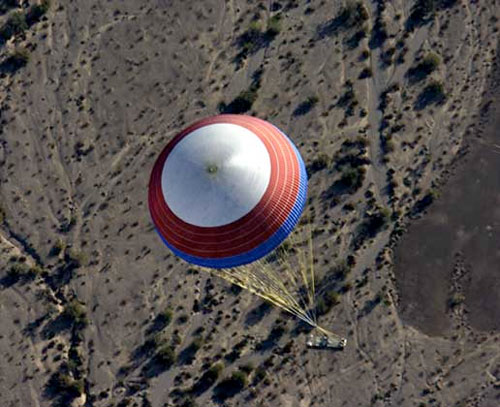
The main parachute for Constellation Program rockets is tested Nov. 15 over the U.S. Army's Yuma Proving Ground near Yuma, Ariz. Measuring 150-feet in diameter and weighing 2,000 pounds, the parachute is the largest of its kind that's been tested. Outfitted with a 42,000-pound weight to simulate the load of a first stage, the main parachute was dropped from a U.S. Air Force C-17 aircraft flying at an altitude of 16,500 feet. The one-ton parachute and all supporting hardware functioned properly, landing safely approximately three minutes later on the Yuma Proving Ground test range. The parachute system will allow Ares I and Ares V first stage boosters to be recovered and reused. Exploring the moon and beyond is the focus of Constellation Program, which is developing a new family of U.S. launch vehicles, spacecraft and related systems for exploration.
|
Robert Pearlman
Editor Posts: 50516
From: Houston, TX
Registered: Nov 1999
|
 posted 07-24-2008 02:00 PM
posted 07-24-2008 02:00 PM
   
NASA release 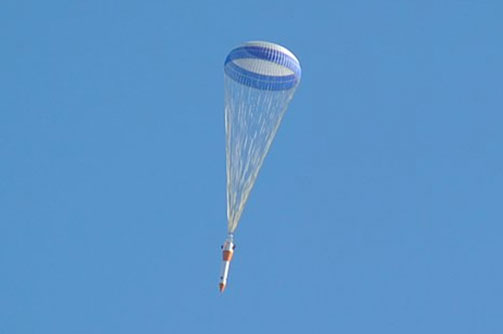
NASA Successfully Tests Parachute for Ares RocketNASA and industry engineers have successfully completed the first drop test of a drogue parachute for the Ares I rocket. The drogue parachute is designed to slow the rapid descent of the spent first-stage motor, cast off by the Ares I rocket during its climb to space. The successful test is a key early milestone in development and production of the Ares I rocket, the first launch vehicle for NASA's Constellation Program that will send explorers to the International Space Station, the moon and beyond in coming decades. The drogue parachute is a vital element of the Ares I deceleration system and will permit recovery of the reusable first-stage motor for use on future Ares I flights. Engineers from NASA's Marshall Space Flight Center in Huntsville, Ala., managed the team that conducted the first Ares I drogue chute test on July 24 at the U.S. Army's Yuma Proving Ground near Yuma, Ariz. This is the sixth in an ongoing series of tests supporting development of the Ares I parachute recovery system, which includes a pilot chute, drogue and three main parachutes. The next drogue parachute test is scheduled for October, and testing will continue through 2010. The drogue parachute also will be used during NASA's first test flight for the Ares rocket, the Ares I-X, scheduled to take place in 2009. Researchers dropped the 68-foot-diameter drogue parachute and its 36,000-pound load -- simulating the first-stage motor -- from a U.S. Air Force C-17 aircraft flying at an altitude of 25,000 feet. The parachute and all test hardware functioned properly and landed safely. The parachutes that serve as the Ares I recovery system are similar to the four-segment space shuttle boosters, but they have been redesigned to accommodate new requirements of the Ares I first stage. Dramatically larger and more powerful than the shuttle's boosters, the Ares I will have a five-segment solid rocket booster -- causing it to fall faster from a much higher altitude after separation from the launch vehicle. During launch, the Ares I first-stage booster will separate from the upper stage at an elevation of 189,000 feet, approximately 126 seconds into flight. After freefalling to approximately 15,740 feet, the booster's nose cap will be jettisoned, releasing the pilot parachute, which in turn releases the drogue, slowing the stage's descent from 402 mph to 210 mph and maneuvering the booster into a vertical position. Finally, a cluster of three main parachutes, each 150 feet in diameter, will be deployed. The main parachutes continue to slow the booster to splashdown in the Atlantic Ocean. Beginning in 2015, the Ares I rocket will launch the Orion crew capsule and six astronauts, and small pressurized cargo payloads, to the International Space Station. The Ares I rocket, an in-line, two-stage rocket configuration, will be powered by the first stage solid rocket motor for the first two minutes of launch. ATK Launch Systems near Promontory, Utah, is the prime contractor for the first stage booster. ATK's subcontractor, United Space Alliance of Houston, is responsible for design, development and testing of the parachutes at its facilities at NASA's Kennedy Space Center, Fla. NASA's Johnson Space Center in Houston manages the Constellation Program, which includes the Ares I rocket, the Ares V heavy-lift launch vehicle, the Orion crew capsule, the Altair lunar lander. Marshall Space Flight Center manages the Ares Projects. The U.S. Army's Yuma Proving Ground provides the test range, support facilities and equipment to NASA for parachute testing. |
Robert Pearlman
Editor Posts: 50516
From: Houston, TX
Registered: Nov 1999
|
 posted 03-02-2009 03:19 PM
posted 03-02-2009 03:19 PM
   
NASA release NASA Successfully Tests Parachute for Ares RocketNASA and industry engineers successfully completed the second drop test of a drogue parachute for the Ares I rocket. The test took place Feb. 28 at the U.S. Army's Yuma Proving Ground near Yuma, Ariz. The Ares I, the first launch vehicle in NASA's Constellation Program, will send explorers to the International Space Station, the moon and beyond in coming decades. The drogue parachute is a vital element of the rocket's deceleration system; it is designed to slow the rapid descent of the spent first-stage motor that will be jettisoned by the Ares I during its climb to space. The parachute will permit recovery of the reusable first-stage motor for use on future Ares I flights. The first-stage solid rocket motor will power the Ares I rocket for the first two minutes of launch. This was the seventh in an ongoing series of flight tests supporting development of the Ares I parachute recovery system, which includes a pilot chute, drogue and three main parachutes. Researchers dropped the 68-foot-diameter drogue parachute and its 50,000-pound load, which simulates the rocket's spent first-stage motor, from a U.S. Air Force C-17 aircraft flying at an altitude of 25,000 feet. The parachute and all test hardware functioned properly and landed safely. The parachutes being developed for the Ares I recovery system are similar to those used for the four-segment space shuttle boosters, but they have been redesigned to accommodate new requirements of the Ares I first stage. The Ares I will have a five-segment solid rocket booster that will move faster and fall from a higher altitude than the shuttle boosters. Engineers from NASA's Marshall Space Flight Center in Huntsville, Ala., manage the team that conducted the test. ATK Launch Systems near Promontory, Utah, is the prime contractor for the first stage booster. ATK's subcontractor, United Space Alliance of Houston, is responsible for design, development and testing of the parachutes at its facilities at NASA's Kennedy Space Center in Florida. NASA's Johnson Space Center in Houston manages the Constellation Program, which includes the Ares I rocket, the Ares V heavy-lift launch vehicle, the Orion crew spacecraft and the Altair lunar lander. Marshall manages the Ares Projects. The U.S. Army's Yuma Proving Ground provides the test range, support facilities and equipment to NASA for parachute testing. 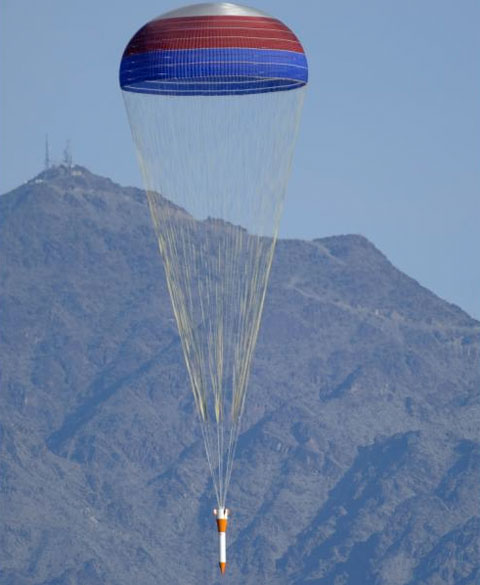 |
Robert Pearlman
Editor Posts: 50516
From: Houston, TX
Registered: Nov 1999
|
 posted 05-21-2009 02:28 PM
posted 05-21-2009 02:28 PM
   
NASA release NASA Tests Largest Rocket Parachutes Ever for Ares INASA and industry engineers successfully completed the first test of the Ares I rocket's three main parachutes Wednesday. The parachutes -- the largest rocket parachutes ever manufactured -- are designed to slow the rapid descent of the rocket's spent first-stage motor, permitting its recovery for use on future flights. The Ares I, the first rocket in NASA's Constellation Program, is designed to launch explorers aboard the Orion crew capsule on journeys to the International Space Station, the moon and beyond. The three main parachutes measure 150 feet in diameter and weigh 2,000 pounds each. They are a primary element of the rocket's deceleration system, which also includes a pilot parachute and drogue parachute. Deployed in a cluster, the main parachutes open at the same time, providing the drag necessary to slow the descent of the huge solid rocket motor to a soft landing in the ocean. "The successful main chute cluster test today confirms the development and design changes we have implemented for the Ares I first stage recovery system," said Ron King, Ares I first stage deceleration subsystem manager for the Ares Projects at NASA's Marshall Space Flight Center in Huntsville, Ala. "Thanks to our great, collaborative team, the test went as anticipated, and all of our design objectives were met." Engineers from Marshall managed the team that conducted this first cluster test at the U.S. Army's Yuma Proving Ground near Yuma, Ariz. This was the eighth in an ongoing series of flight tests supporting development of the Ares I recovery system. Researchers dropped the 41,500-pound load from a U.S. Air Force C-17 aircraft flying at an altitude of 10,000 feet. The parachutes and all test hardware functioned properly and landed safely. As the test series progresses, engineers will perform three classifications of testing: development, design load and overload. Each level of testing is designed to fully test the performance of the new parachute design with different size payloads under varying conditions. The next test in the cycle -- scheduled for fall 2009 -- will involve the first design limit load test of a single main parachute. The Ares I recovery system currently under development uses parachutes similar to those used for the four-segment space shuttle boosters, but the parachutes have been redesigned to accommodate the new requirements of the Ares I first stage. The Ares I launch vehicle will have a five-segment solid rocket booster that will fly faster and fall from a higher altitude than the shuttle boosters. ATK Space Systems near Promontory, Utah, is the prime contractor for the first stage booster. ATK's subcontractor, United Space Alliance of Houston, is responsible for design, development and testing of the parachutes at its facilities at NASA's Kennedy Space Center in Florida. NASA's Johnson Space Center in Houston manages the Constellation Program. Marshall manages the Ares Projects. The U.S. Army's Yuma Proving Ground provides the test range, support facilities and equipment to NASA for parachute testing. |
Robert Pearlman
Editor Posts: 50516
From: Houston, TX
Registered: Nov 1999
|
 posted 10-08-2009 04:56 PM
posted 10-08-2009 04:56 PM
   
ATK releaseATK and NASA Team Complete another Successful Ares I Main Parachute Drop-TestAlliant Techsystems, the prime contractor for the first stage of the Ares I launch vehicle, along with NASA, the U.S. Army, and United Space Alliance (USA), successfully conducted the third in a series of four Ares I main parachute drop-tests. These tests aid the development of the deceleration system for the Ares I First Stage solid rocket motor. The test was conducted at the Army's Yuma Proving Grounds. The test consisted of extracting a 72,000 pound test payload from a C-17 aircraft flying at 25,000 feet, tying the record for largest single payload pulled from a C-17. Following the extraction, a 60,000 pound test article (jumbo dart) was separated from the pallet. The jumbo dart was then allowed to accelerate to the desired conditions before the 150-foot-diameter main parachute was deployed. The objective of this test was to develop and measure a load on the main parachute similar to that expected during Ares I flight. 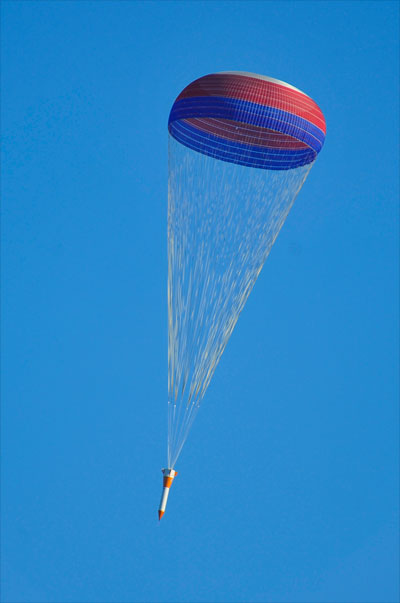
Credit: ATK "This is yet another successful milestone for the Ares I program, which has been steadily progressing over the past four years," said Mike Kahn, executive vice president of ATK Space Systems. "We are looking forward to seeing this parachute system function in just a matter of weeks during the launch of Ares I-X." The newly-developed Ares I parachute system is already packed and ready to be used operationally during the flight test of Ares I-X, a full scale launch vehicle with an inert upper stage. Ares I-X is one of many systems that will provide valuable flight data that will aid in finalizing the design of Ares I. The Ares I launch vehicle, which is slated to replace the Space Shuttle, utilizes a five-segment reusable solid rocket developed from the twin four-segment boosters used to launch the Space Shuttle. Like the recovery system for the shuttle boosters, the Ares first stage recovery system will consist of pilot and drogue chutes that reorient and decelerate the used solid rocket motor prior to deploying a cluster of three main parachutes. Due to the added weight of the extra segment on Ares I and the higher apogee reached by the Ares first stage, the main parachutes for the Ares recovery system were designed to be 20% larger than the one currently used on the shuttle boosters. The parachutes were designed and manufactured by USA at the Kennedy Space Center under a subcontract to ATK. To date, ATK and its partners have successfully conducted three pilot, two drogue, three single main, and one main cluster parachute drop tests. Four additional parachute drop tests are planned over the next two years. Ares I-X will be the next test of the entire system, followed by further testing next spring. 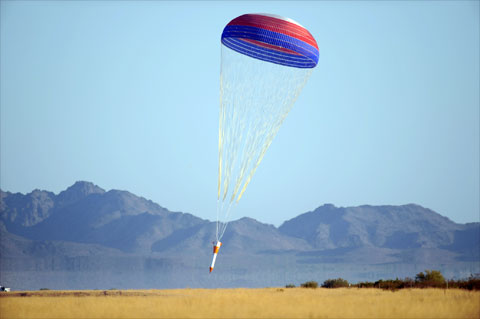
Credit: ATK |
Robert Pearlman
Editor Posts: 50516
From: Houston, TX
Registered: Nov 1999
|
 posted 04-14-2010 06:49 PM
posted 04-14-2010 06:49 PM
   
Alliant Techsystems release ATK and NASA Team Break World Record with Successful Ares I Parachute Drop TestDrogue Parachute Passes Third Key Test for NASA Ares I Program Alliant Techsystems, along with NASA, the U.S. Army, and United Space Alliance (USA), broke the record for the largest single load extracted out of a C-17 aircraft as they successfully conducted an Ares I drogue parachute drop-test.
The test was conducted at the U.S. Army's Yuma Proving Grounds as the team deployed a record-breaking weight of 77,000 pounds of payload from a C-17 aircraft flying at 25,000 feet. The previous record was 72,000 pounds. Following release, the test article was allowed to accelerate to a pre-determined velocity before the 68-foot diameter drogue parachute was deployed.
The drogue parachute is designed to reorient and decelerate the first stage booster to an acceptable speed and condition before the three main parachutes are deployed. This test exercised the drogue parachute to its' intended 450,000 pound design load for the Ares I first stage. Initial data indicate the test met all objectives.
Similar to the shuttle program, the Ares I first stage solid rocket motor is designed to be recovered to collect valuable post-flight data and reused. These data aid engineers in understanding the motor's performance, ensuring it remains within design parameters.
"The postflight data we collect from the shuttle program and now in the next generation are a unique key element to human-rating," said Charlie Precourt, vice president and general manager Space Launch Systems, ATK Aerospace Systems. "Today's test validates the deceleration system will work in future flights and continue to provide us with a wealth of information."
The main parachutes for the Ares I recovery system are 20 percent larger than the one currently used on the shuttle boosters, to accommodate for the added weight of the fifth segment. The system was tested during the Ares I-X flight and had a minor anomaly when a reefing line prematurely fired, causing one of the main parachutes to fail. The booster was still recovered and engineers have identified design solutions that will prevent this failure on future flights.
This test was the third in a series of four planned drogue parachute drop tests. The final test will be an overload test, testing the parachute beyond the load expected for normal operations.
The parachutes are designed and manufactured by USA at the Kennedy Space Center under a subcontract to ATK. To date, ATK and its partners have successfully conducted three pilot, three drogue, three single main, and one main cluster parachute drop tests. Three additional parachute drop tests are planned over the program. | |
Contact Us | The Source for Space History & Artifacts
Copyright 2023 collectSPACE.com All rights reserved.

Ultimate Bulletin Board 5.47a
|
|

|
 advertisement advertisement

|

















